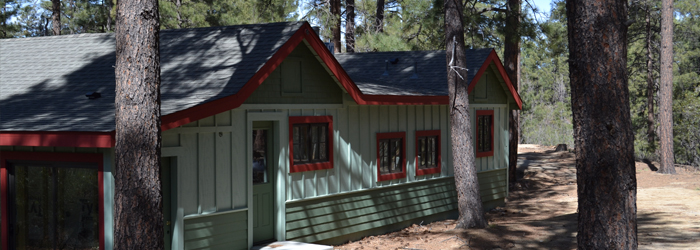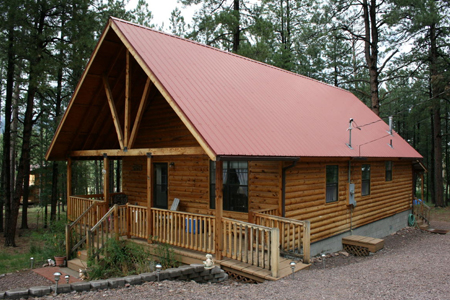10 Questions to Ask Before You Buy a Little Cabin in the Big Woods
 21 June 2016
21 June 2016 

Daydreaming about buying your very own wilderness cabin? Somewhere at 8,000 feet where the highs are in the 80s in summer and the lows are in the 50s? Just a small place, not too expensive? The problem: Lots of people want the same thing and choices are few.
Theresa Allison, owner of Alpine Realty in Apache County, says only one newly built cabin was for sale in her area as of mid-June. The cabin ($200,000) is on a half-acre with water and sewer connections and year-round access. But many empty lots are for sale as well as older cabins that need some work.
Although you have to be careful about any real estate purchase, what draws me to Northern Arizona is the breezes running through the quaking aspen leaves and the knowledge that I’m out of cell and Wi-Fi range.
So here are 10 questions to ask before buying a lot or cabin in rural Arizona:
 1. How restrictive is the planning department?
1. How restrictive is the planning department?
How restrictive is the planning department? Planning in rural areas is being more tightly controlled. Find out about any covenants or deed restrictions on the lot you want to buy so you can build your cabin to suit the rules.
2. Was the cabin you’re looking at constructed without a building permit?
According to Tom Reilly, a Remodler in the Prescott area, Yavapai County (and many other places in Arizona) didn’t require permits for cabins until about 15 years ago. That may mean the need for some repairs after you buy to bring your cabin up to code.
3. If you buy a vacant lot, how hard will it be to develop?
In rural areas, you can spend a lot more time and money than you expected building a cabin and access road. Just delivering building materials can be expensive.
4. Will you have access to water?
Many lots have no hookups to treated domestic water. But you can have water hauled in to fill a large water tank. Or you can drill a well. If there’s an existing water tank or well, you want it properly tested for safety.
5. Are there sewers?
Probably not. Instead you need an approved septic system. Some existing septic systems were installed without permits and need repairs. Sometimes a standard septic system will not work on rocky soil or steep slopes; then you need an alternative -- an evaporation-transpiration system (ET) that could cost up to $20,000.
6. What about heat and electricity?
In many cases, cabin owners use solar or wind power or a generator besides a wood-burning stove.
7. What repairs does your cabin need?
In an existing cabin, have home and septic system inspections to indicate what issues are. Most likely the cabin has log walls -- a popular option in Northern Arizona. But those walls may need maintenance in older homes.
8. Can you park an RV on the property in the summer if there’s no cabin?
Can you have a modular (manufactured home) or a “tiny” house brought on site? If there are no deed restrictions, sometimes you can use an RV, mobile home or “tiny” portable house in summer. But these structures sometimes cannot stand up to snowfall, says Allison. New manufactured homes are sometimes allowed permanently, but they must meet federal standards for the snow load on the roof.
9. How else will winter weather affect you?
During storms, some roads, including county maintained roads, can be impassable. You may need a four wheel-drive vehicle to travel safely in the winter. Find out who plows the roads and where and when they do it.
10. How far away from your city home should a cabin be?
Alpine County, for example, is about 250 miles or about five hours from Phoenix. But if you’re willing to travel that far for a weekend or a vacation, prices can be lower than in locations like Yavapai County.
After considering all those sticky issues, many of us still yearn for a taste of really rustic life in rural Arizona. It’s not just the weather; it’s also the mountains covered with big trees and the streams, rivers and lakes and a chance to get away from it all, something that’s getting rarer in modern America all the time.
###
Photo Credits:
- Content photo: Alpine Realty
RELATED CONTENT:
- DIY Q&A: Tips to get your cabin into shape
- DIY Q&A: How do I clean a wood deck?
- Need a trusted contractor in Northern Arizona? Search here.
- Weekly Podcast: Subscribe for free!
- DIY Video (View): 5 HVAC DIY Tips
Print this page
recent post
- Duck, Duck, Duct! How Often Should Ductwork Be Cleaned?
- Vinyl vs. Fiberglass Windows: Which Is The Better Choice Of Replacement Window?
- We May Be The Grand Canyon State, But The Rocky Mountains Are Important For Arizona
- Welcome to Arizona! Things A Newbie to Arizona Should Know
- The Pros & Cons of Buying A Flipped House
- Getting In On The Ground Floor
- Why It’s More Critical Than Ever To Get Your AC Serviced Before Summer
- The Reality of Remodeling
- What To Look For When Comparing Your Roofing Quotes
- What To Expect When Buying New Windows & Doors
